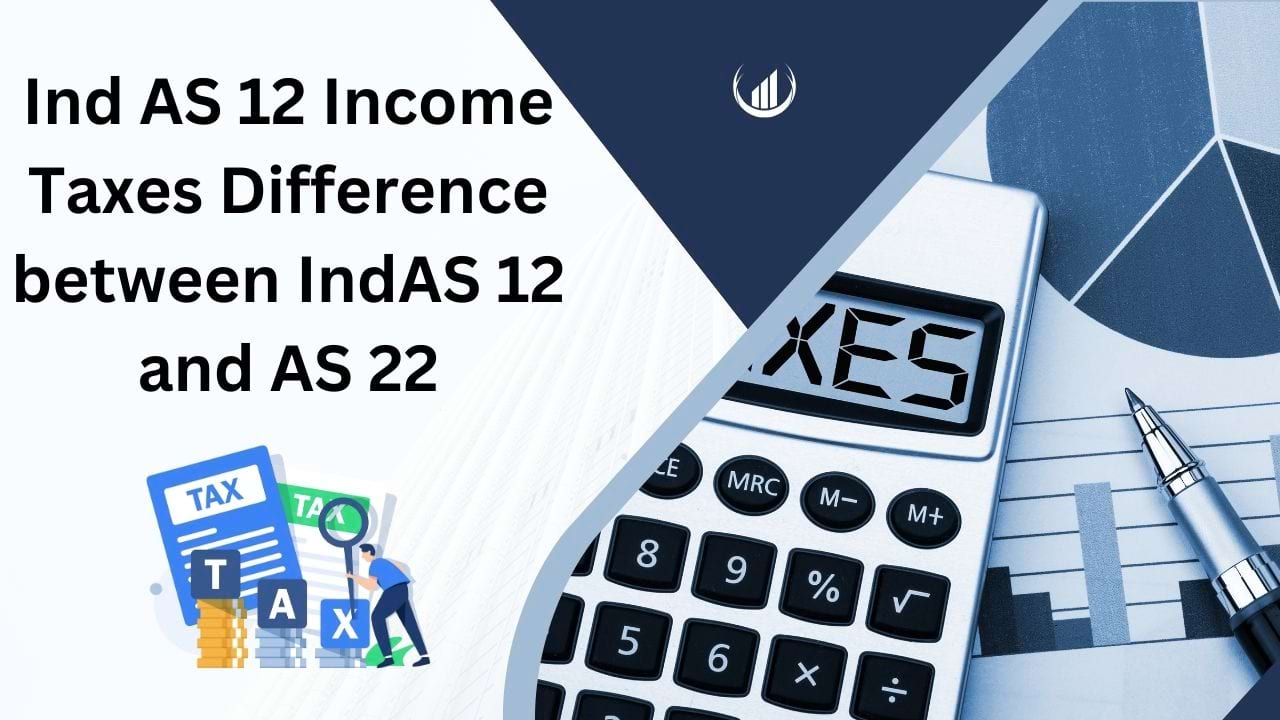Ind AS 12, Income Taxes: Ind AS 12 prescribes the accounting treatment for income taxes. For this Standard, income taxes include all domestic and foreign taxes which are based on taxable profits. Income taxes also include taxes, such as withholding taxes, which are payable by a subsidiary, associate, or joint venture on distributions to the reporting entity.
The principal issue in accounting for income taxes is how to account for the current and future tax consequences of:
- the future recovery (settlement) of the carrying amount of assets (liabilities) that are recognized in an entity’s statement of financial position; and
- transactions and other events of the current period that are recognized in an entity’s financial
Ind AS 12 also deals with the recognition of deferred tax assets arising from unused tax losses or unused tax credits, the presentation of income taxes in the financial statements, and the disclosure of information relating to income taxes. You may also like Bills of Exchange.
Ind AS 12 is based on the balance sheet approach. It requires recognition of tax consequences of the difference between the carrying amounts of assets and liabilities and their tax base.
Quick Links
Recognition
Current tax for current and prior periods shall, to the extent
unpaid, be recognized as a liability. If the amount already paid in respect of current and prior periods exceeds the amount due for those periods, the excess shall be
recognized as an asset.
It is inherent in the recognition of an asset or liability that the reporting entity expects to recover or settle the carrying amount of that asset or liability. If it is probable that recovery or settlement of that carrying amount will make future tax payments larger (smaller) than they would be if such recovery or settlement were to have no tax consequences, this Standard requires an entity to recognize a deferred tax liability (deferred tax asset), with certain limited exceptions.
A deferred tax asset shall be recognized for the carry forward of unused tax losses and unused tax credits to the extent that it is probable that future taxable profit will be available against which the unused tax losses and unused tax credits can be utilized. Must Read Features of the Ledger Account.
Measurement
Current tax liabilities (assets) for the current and prior periods shall be measured at the amount expected to be paid to (recovered from) the taxation authorities, using the tax rates (and tax laws) that have been enacted or substantively enacted by the end of the reporting period.
Deferred tax assets and liabilities shall be measured at the tax rates that are expected to apply to the period when the asset is realized or the liability is settled, based on tax rates (and tax laws) that have been enacted or substantively enacted by the end of the reporting period.
The measurement of deferred tax liabilities and deferred tax assets shall reflect the tax consequences that would follow from how the entity expects, at the end of the reporting period, to recover or settle the carrying amount of its assets and liabilities. You may also like Users of Accounting Information.
Deferred tax assets and liabilities shall not be discounted
The carrying amount of a deferred tax asset shall be reviewed at the end of each reporting period. An entity shall reduce the carrying amount of a deferred tax asset to the extent that it is no longer probable that sufficient taxable profit will be available to allow the benefit of part or all of that deferred tax asset to be utilized. Any such reduction shall be reversed to the extent that it becomes probable that sufficient taxable profit will be available.
Allocation
This Standard requires an entity to account for the tax consequences of transactions and other events in the same way that it accounts for the transactions and other events themselves. Thus, for transactions and other events recognized in profit or loss, any related tax effects are also recognized in profit or loss. For transactions and other events recognized outside profit or loss (either in other comprehensive income or directly in equity), any related tax effects are also recognized outside profit or loss (either in other comprehensive income or directly in equity, respectively).
Similarly, the recognition of deferred tax assets and liabilities in a business combination affects the amount of goodwill arising in that business combination or the amount of the bargain purchase gain recognized.
Appendix A of Ind AS 12 addresses how an entity should account for the tax consequences of a change in its tax status or that of its shareholders. The Appendix prescribes that a change in the tax status of an entity or its shareholders does not give rise to increases or decreases in amounts recognized outside profit or loss. The current and deferred tax consequences of a change in tax status shall be included in profit or loss for the period, unless those consequences relate to transactions and events that result, in the same or a different period, in a direct credit or charge to the recognized amount of equity or in amounts recognized in other comprehensive income.
Those tax consequences that relate to changes in the recognized amount of equity, in the same or a different period (not included in profit or loss), shall be charged or credited directly to equity. Those tax consequences that relate to amounts recognized in other comprehensive income shall be recognized in other comprehensive income.
Difference between IndAS 12 and AS 22
| AS 22 | IND AS 12 |
|---|---|
| Fewer disclosures are required as compared to IND AS 12 | More disclosures are required as compared to AS 22 |
| Provides guidance regarding tax rates to be applied/used for measuring deferred tax assets/liability when a company pays tax under section 115JB. | Does not specifically deal with this aspect. |
| AS 22 explains the concept of virtual certainty, supported by convincing evidence, and states that the deferred tax assets, arising as a result of unabsorbed depreciation and carry forward of losses shall be recognized only to the extent that there is virtual certainty, supported by convincing evidence. | The concept of virtual certainty has been dispensed with, by IND AS 12 and hence, there is no such explanation under IND AS 12. |
AS 22 guides the recognition of deferred tax in the case of:
| Ind AS 12 does not specifically deal with these situations. |
| AS 22 does not deal with this aspect. | Ind AS 12 guides how an entity should deal with tax consequences arising as a result of a change in its tax status or the tax status of its shareholders. |
| AS 22 follows an “Income statement” approach. It focuses on the differences between taxable profit and accounting profit, which originate in one period and are subject to reversal in subsequent periods. Hence, deferred tax expense or benefit is computed first and then the corresponding deferred tax asset or liability is arrived at. | IND AS 12 follows the “Balance Sheet” approach. It focuses on the differences between the book balance and tax balance of assets and liabilities. Such differences are called timing differences. Hence, deferred tax asset or liability is computed first and then the corresponding deferred tax expense or saving is arrived at. |
| Deferred taxes are not recognized on such eliminations in IGAAP. | Under Ind AS, deferred taxes are recognized on temporary differences that arise from the elimination of profits and losses resulting from intra-group transactions. |
| It does not deal with this aspect. | IND AS 12 states that DTA/DTL arising from the revaluation of assets shall be measured based on tax consequences arising on the sale of the asset, rather than on use. |
| Existing AS 22 does not specifically deal with this aspect. | The current tax expense, as well as the deferred tax income/expense, is ideally recognized in the statement of profit or loss for the period. But, if the deferred tax income or expense arises from a transaction or an event that is disclosed either in:
|







